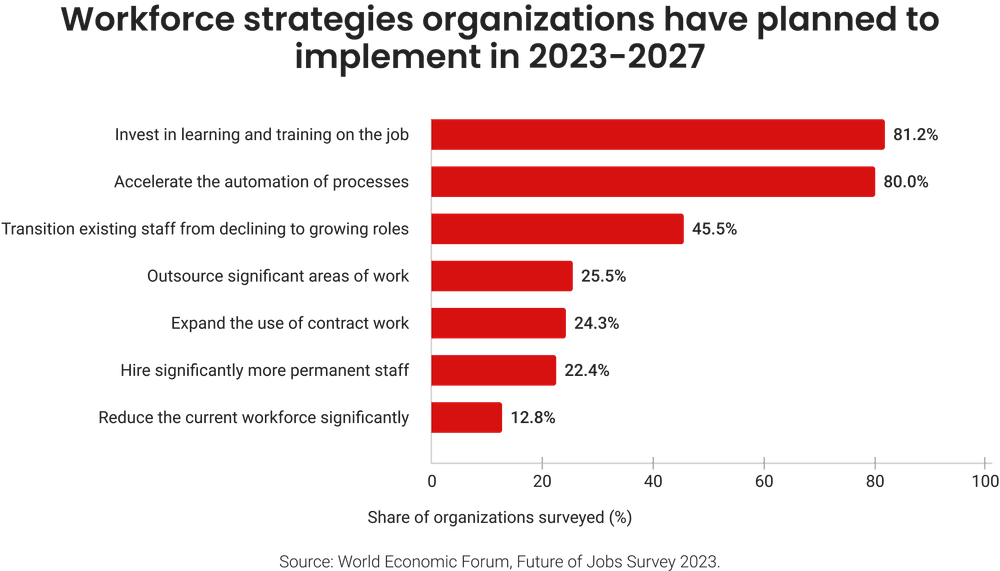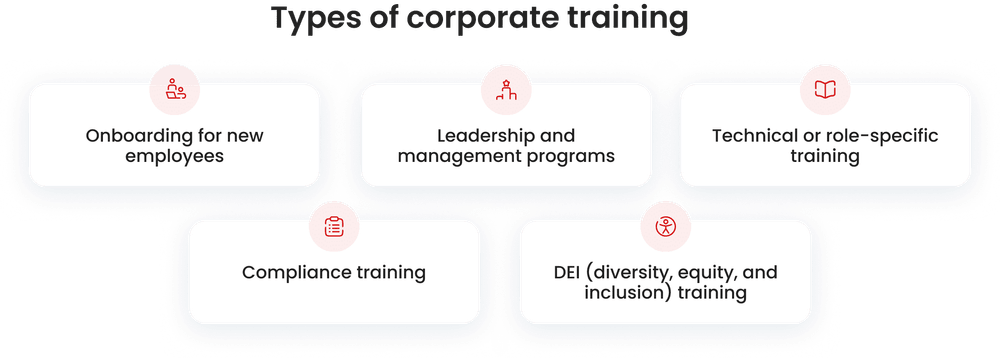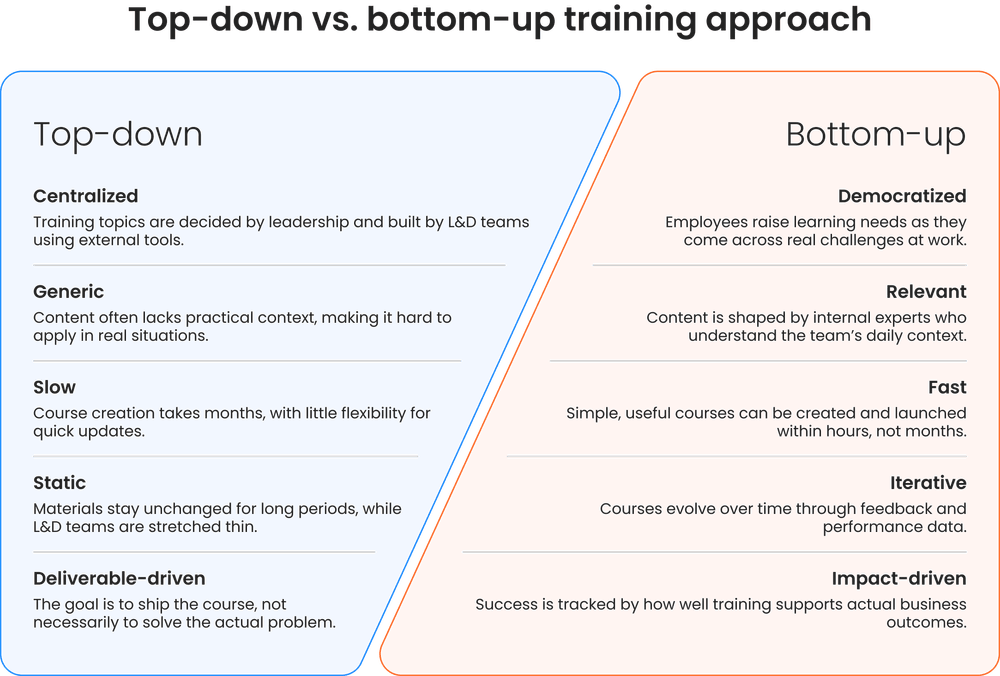Is it easier to train a strong specialist or to hire one?
For years, companies have leaned toward hiring. But the reality is changing. Recruitment takes time, good candidates are rare, and business needs don’t wait. At the same time, many corporate training programs are outdated, disconnected from actual tasks, and slow to show value.
Retention is part of this shift too. With only 3 out of 10 employers successfully filling their job openings, keeping skilled people and building from within has never been more important.
That’s why more companies are working to create environments where employees feel valued, heard, and supported in their growth.
In this article, we explore how corporate learning is changing, what new approaches are already in use, and what it takes to apply them inside a company. Keep reading.
What do modern businesses think about L&D?
What do today’s companies expect from corporate learning and development? Quite a lot, actually.
According to the World Economic Forum’s 2023 survey, training and upskilling are no longer seen as side projects or HR add-ons. They are becoming one of the key strategies to keep businesses moving forward.
In fact, over 81% of surveyed companies say that investing in on-the-job learning and training is among their top priorities for the next five years. This is the most commonly mentioned approach, tied closely with automation, which shares the same level of attention.

In simple terms: if companies want to hit their business goals in the next five years, most of them don’t plan to hire their way out of skill gaps. They plan to train.
A more recent response confirms this: according to the UK’s 2024 Labour Market Overview, increased investment in employee training and talent retention are now top priorities for many organizations.
This trend becomes even clearer when looking at how companies assess their talent outlook. When asked about the future availability of talent, only 39% said they feel optimistic, while 38% expect it to get worse – a split view, with no clear direction. But when the same companies look inward, the tone changes.
53% feel positive about talent retention, and just 19% worry about losing people. Even more telling: 77% of companies are confident they can improve the skills of their existing workforce, while only 5% see that as a problem. That’s a net 72% leaning toward optimism.

These numbers show a clear shift: organizations are no longer relying on external hiring as their main solution. They are betting on the people they already have – and trying to give them better tools, better knowledge, and better reasons to stay.
If training used to be seen as support, it’s now seen as infrastructure.
What is corporate training?
Corporate training isn’t just about teaching employees how to do their jobs. It’s a system for building the kind of workforce a business actually needs – now and in the future.
And no, it’s not one-size-fits-all. Companies use different types of training depending on goals, roles, and context.
Here are five common types of corporate training you’ll find in most organizations today:

1. Onboarding for new employees
The first weeks in a new role can shape how long someone stays and how well they perform. Structured onboarding helps new hires understand how the company works, what’s expected of them, and how to get started without wasting time.
It covers company policies, internal tools, communication styles, and workplace culture.
2. Leadership and management programs
People don’t become good managers just by getting promoted. They need practical training. This can cover communication, conflict resolution, feedback skills, time management, and decision-making. For experienced leaders, it’s a chance to reflect, adjust, and stay sharp in fast-changing environments.
3. Technical or role-specific training
Every job comes with its own tools and methods. Whether it’s programming, engineering, working with equipment, or using industry-specific software – employees need to know how to do it properly. And since tools change quickly, this kind of training isn’t just for new hires.
4. Compliance training
Some knowledge isn’t optional. Legal, safety, and policy-related training helps teams follow the rules – whether it’s GDPR, FCPA, OSHA, or internal codes of conduct. It’s not the most exciting part of training, but it’s necessary and often mandatory.
5. DEI (Diversity, Equity, and Inclusion) training
This type of training focuses on workplace awareness and behavior. It may include topics like unconscious bias, cultural sensitivity, inclusive language, and respectful communication. The goal is to create a space where people feel safe and valued regardless of their background.
While the list can go on, these five are among the most widely used today. They cover both practical and people-centered topics – making sure employees know what to do and how to work well together.
Top approaches in employee training and development in 2025 and beyond
The way people learn at work is changing. Fast. In 2025, the traditional approach to corporate training is giving way to more flexible, dynamic, and personalized models.
Employees expect more than standard PowerPoints and annual seminars – and forward-thinking organizations are delivering.
Here are the key learning and development approaches to implement in 2025.

Shift from top-down to bottom-up learning
This isn’t just a trend in training; it’s a broader shift we’re seeing in how companies operate. The old top-down model, where leadership defines what’s important and everyone else follows, is slowly being replaced with a bottom-up approach that puts employees in control of their own learning paths.
In top-down learning, the corporate decides: what to learn, when, and how. In bottom-up learning, employees take a more active role. They choose what skills to build based on their roles, interests, or career goals – and companies support them with tools, platforms, and mentorship.

For example, a software developer might want to explore cloud architecture even though it’s not currently part of their job. In a bottom-up culture, they’d have access to learning platforms, internal communities, or learning credits to do that without waiting for approval from above.
Measuring learning by business impact
Measuring the success of employee training used to focus on simple things: how many people completed a course or left good feedback. But in 2025, that’s no longer enough. LinkedIn Learning reports that “aligning learning programs with business goals” is the top priority for L&D teams in 2025.
Today, L&D is expected to support big business goals like employee retention, performance improvement, and faster onboarding. And if training programs want to stay relevant – and funded – they need to prove that impact in clear, measurable terms.
That means tying learning outcomes to real KPIs. For example:
- A training for sales teams that leads to higher deal sizes
- Onboarding programs that cut down ramp-up time for new hires
- A focus on leadership skills that improves team retention
- Compliance modules that bring the company to full audit readiness
Executives understand hiring costs, churn rates, and missed targets – so L&D teams need to speak that language too. Each new course should start with a business question: “What problem are we solving?” and end with an answer backed by data.
Microlearning
Another big trend gaining traction in 2025 is microlearning – the art of breaking down training into small, bite-sized lessons.
Instead of sitting through a 2-hour webinar, employees get content in chunks: a 5-minute video, a quick interactive quiz, or a short case study they can complete during a coffee break.
This approach fits modern attention spans, works better with busy schedules, and improves retention. Studies show people are more likely to remember what they learned in shorter, focused sessions than long, dense ones.
For example, a customer support team might get a weekly microlesson on handling objections, with one scenario and one tip per session. After a few weeks, they’ve built a solid set of tools without feeling overloaded.
A blended learning approach
Blended learning – the mix of online and face-to-face training – isn’t new, but it’s more relevant than ever. As hybrid work continues, companies need a model that combines the flexibility of online learning with the human connection of in-person workshops.
Online sessions cover foundational knowledge: theory, tools, frameworks. Then, live sessions (on-site or virtual) are used for discussion, practice, and reflection.
Let’s say a company runs leadership training. Employees might complete eLearning modules on decision-making, then join live sessions to role-play scenarios and get feedback. The advantage? People come prepared, sessions are more engaging, and learning becomes something you experience – not just consume.
A culture of continuous learning
Learning shouldn’t feel like a checkbox. The real shift comes when training becomes part of the everyday – not something that only happens during performance review season.
But that doesn’t happen by accident. Companies need to create environments where learning feels enjoyable, rewarding, and connected to long-term growth.
Employees stay motivated when they want to learn – not just when they have to. That means giving access to useful content, creating space during the workweek, and recognizing progress.
It also means showing people where their efforts are going: skill-building for a promotion, a future role, or even personal development. When there’s a clear path forward, people are more likely to stay engaged.
Gamification
Gamification isn’t new, but it’s not going anywhere. In fact, it’s one of the few L&D trends that keeps proving its value year after year.
Adding elements like points, challenges, leaderboards, and badges might sound like fun and games – and that’s exactly the point. According to statistics, around 90% of employees say gamification makes them more productive at work.
It taps into motivation: people enjoy progress, they like friendly competition, and they remember more when they’re engaged.
For example, a sales team might get points for completing product knowledge quizzes, with small rewards at each level. Over time, it boosts knowledge, creates momentum, and builds team spirit.
Adaptive learning
Gone are the days of one-size-fits-all training programs. Today, there’s growing recognition that each employee brings a different mix of experience, learning style, and goals. So why should everyone go through the same training course?
Personalized learning means building training paths that adapt to the individual – not the other way around. This can involve skill assessments to identify gaps, AI-powered recommendations, modular content, or even personalized coaching plans.
For instance, two employees in the same role might have completely different needs. One may benefit from brushing up on communication, the other on data skills. Personalized learning paths let both reach their next career milestone, without wasting time on irrelevant content.
The benefit is clear: employees learn faster, retain more, and stay more motivated – because the content feels relevant.
Learn more about adaptive learning and how AI contributes to it in our article.
How AI brings modern training trends to life
While AI is often spoken of as a standalone trend, in corporate learning it plays a quieter role, helping many of today’s approaches work more efficiently. Although the technology has many applications, let’s take a closer look at some of the most promising use cases.
Personalized learning paths
One of the strongest AI capabilities in L&D is the automatic generation of learning paths tailored to individual needs. Based on role, skill level, and performance, AI can suggest what to learn, when, and in what format – without manual work from managers or L&D teams.
For employees, it means clearer growth plans. For companies, it means improved internal mobility and more effective use of learning budgets
Content creation
Creating training content from scratch can take weeks. For companies with growing teams or changing products, it’s hard to keep up.
AI tools help simplify this process by generating draft materials – such as course outlines, learning objectives, training texts, or assessment questions – based on existing inputs like job descriptions, manuals, or policies.
For example, in the retail industry, L&D teams use AI to quickly create training modules when new product lines are introduced. Instead of waiting for full-course development, they generate a basic structure and fill in the details with input from product experts. This speeds up onboarding and ensures frontline staff stay up to date.
Knowledge assessment
Traditional assessments often rely on paper tests and static quizzes that don’t show what learners actually understand. AI makes assessment more adaptive and reflective of real performance. It can adjust questions based on responses, identify knowledge gaps, and suggest content to revisit.
For example, finance teams in large corporations use AI-powered assessments during compliance training. If an employee answers incorrectly, the system doesn’t just mark it wrong – it adjusts the next question, revisits the concept, and flags knowledge areas that need reinforcement.
This prevents knowledge gaps from going unnoticed and ensures employees grasp key regulations.
More ideas for AI implementation in employee training
AI is a wide field, and many companies are finding smart ways to use it across the learning cycle. Here are more ways AI supports real training goals today:
- Learner analytics. Track which content works, where learners drop off, and what leads to better performance – so training can continuously improve.
- Virtual tutors and chatbots. Offer learners instant answers to questions, support during e-learning, or guidance through complex topics available 24/7.
- Predictive analytics for learning outcomes. Use historical data to identify which employees are likely to complete training, apply it on the job, or need additional support.
- Skills gap identification. Analyze job requirements vs. current team skills to find missing capabilities – and plan upskilling before problems appear.
- Content recommendation engines. Suggest relevant content based on what similar users in similar roles have completed or rated highly.
Learn more about AI adoption in corporate training – how it solves the biggest headaches and how to implement it effectively.
Bottom line
Trends change, but the goal of corporate learning stays the same – to make employees more effective and their skill – more relevant and useful for real business needs.
Even the now-outdated methods once aimed to improve how people learned at work. Today’s shift is simply the next step: faster, more flexible, and better aligned with how teams actually grow.
At Aristek, we don’t just follow these trends – we work with them. Our team has hands-on experience, practical tools, and a clear understanding of what businesses deal with on the ground. We offer solutions that work in real time, not just in theory.
Book a free consultation to share your goals and challenges. Let’s talk about how we can support your training programs, improve team performance, and help your business move forward.
Corporate training doesn’t have to be boring.
Or slow. Or forgotten two days later. We create practical, engaging programs that teams want to use – and businesses see results from.






